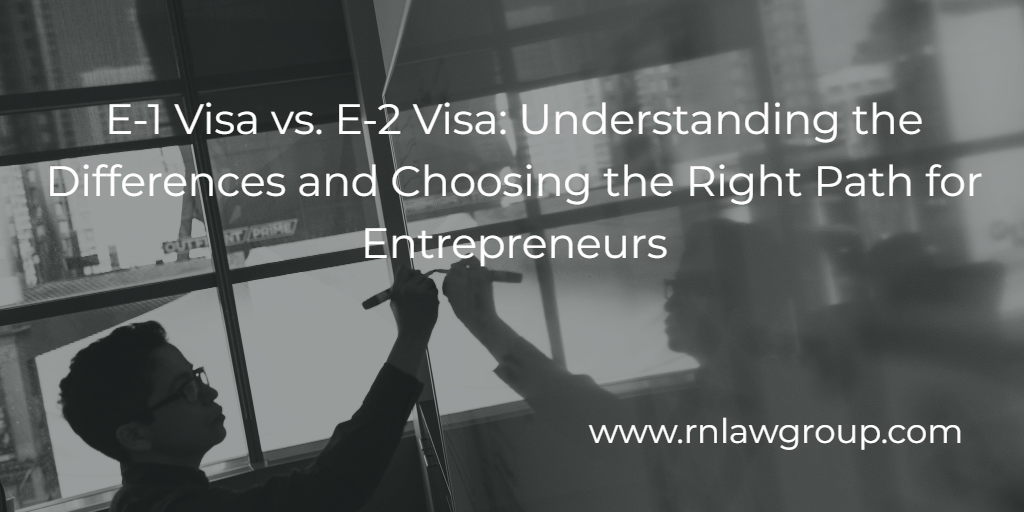
E-1 Visa vs. E-2 Visa: Understanding the Differences and Choosing the Right Path for Entrepreneurs
Introduction
When it comes to pursuing entrepreneurial opportunities in the United States, foreign nationals have several visa options available to them. Two popular choices are the E-1 and E-2 visas. While both visas are designed to facilitate business activities for non-U.S. citizens, they have distinct characteristics and requirements that make them suitable for different types of entrepreneurs. In this article, we will delve into the details of the E-1 visa and E-2 visa, highlighting their differences and helping aspiring entrepreneurs make an informed decision.
E-1 Visa: Treaty Trader Visa
The E-1 visa, also known as the Treaty Trader visa, is designed for individuals engaged in substantial trade between their home country and the United States. This visa category is established under the terms of a trade treaty between the U.S. and the applicant’s home country. To qualify for an E-1 visa, the applicant must be a citizen of a treaty country and be involved in a substantial volume of trade of goods, services, or technology between the U.S. and their home country.
One of the key requirements for the E-1 visa is that the trade must be primarily between the U.S. and the treaty country. The applicant must prove that over 50% of their international trade is conducted with the U.S. Furthermore, the trade must be continuous, significant, and have a clear impact on the U.S. economy. The applicant must also demonstrate that they will be engaged in executive or managerial duties or possess essential skills to oversee and direct the trade activities.
E-2 Visa: Treaty Investor Visa
The E-2 visa, commonly referred to as the Treaty Investor visa, is aimed at foreign entrepreneurs who wish to invest a substantial amount of capital in a U.S. business. Similar to the E-1 visa, the E-2 visa requires the applicant to be a citizen of a treaty country. However, the focus here is on investment rather than trade.
To qualify for an E-2 visa, the applicant must demonstrate that they have made a substantial investment in a U.S. business. The investment must be at risk and proportionate to the total cost of the business. While there is no specific minimum investment amount, it is generally expected to be significant enough to ensure the success and viability of the enterprise. Additionally, the applicant must show that they will actively develop and direct the business, contributing to the U.S. economy and creating job opportunities for U.S. workers.
Key Differences
- Purpose: The E-1 visa caters to individuals engaged in substantial trade, while the E-2 visa is intended for those making substantial investments in a U.S. business.
- Nationality Requirement: Both visas require the applicant to be a citizen of a treaty country. However, the list of eligible treaty countries differs for each visa category. Some countries may have treaties for one visa but not the other.
- Trade vs. Investment: The E-1 visa emphasizes the volume and continuity of trade between the U.S. and the applicant’s home country, while the E-2 visa focuses on the level of capital investment made by the applicant in a U.S. business.
E-1 Visa: Trade
The E-1 visa is designed for individuals engaged in substantial trade between the United States and their home country. Trade, in this context, refers to the exchange of goods, services, or technology between two countries. The emphasis of the E-1 visa is on the volume and continuity of this trade activity.
To qualify for the E-1 visa, the applicant needs to demonstrate that they are involved in a substantial volume of trade with the United States. This means that a significant portion of their business operations should be dedicated to conducting trade activities between their home country and the United States. Additionally, the trade must be continuous and ongoing, showing that it is a regular and integral part of the applicant’s business operations.
E-2 Visa: Investment
In contrast, the E-2 visa places its focus on the level of capital investment made by the applicant in a U.S. business. Rather than trade, the E-2 visa category is specifically designed for individuals who wish to invest a substantial amount of capital in a U.S. enterprise.
The investment made by the applicant must be considered substantial and at risk. While there is no fixed minimum investment amount, it is generally expected to be significant enough to ensure the success and viability of the U.S. business. The investment should be proportional to the total cost of the business or, in some cases, the amount necessary to establish a new business. The key requirement is that the investment is actively used for the development and operation of the U.S. enterprise.
In summary, the E-1 visa focuses on the volume and continuity of trade between the U.S. and the applicant’s home country, while the E-2 visa highlights the level of capital investment made by the applicant in a U.S. business. The E-1 visa is centered around trade activities, whereas the E-2 visa centers around the entrepreneur’s investment in a U.S. enterprise. These distinctions help to differentiate the types of businesses and economic activities that each visa category supports.
- Ownership vs. Employment: While E-1 visa holders can own their businesses, the E-2 visa requires the applicant to have a controlling interest in the U.S. business. The E-2 visa holder is expected to be actively involved in the enterprise, whereas the E-1 visa holder may primarily engage in executive or managerial duties.
Choosing the Right Path
Deciding between the E-1 and E-2 visas depends on various factors, including the nature of your business, the volume of trade or investment, and your long-term goals in the United States.
If you are primarily involved in trade and maintain a substantial volume of trade between the U.S. and your home country, the E-1 visa may be the appropriate choice. On the other hand, if your focus is on making a significant capital investment in a U.S. business and actively managing its operations, the E-2 visa is likely the better fit.
It is crucial to consult with an experienced immigration attorney who can assess your specific circumstances, evaluate the eligibility criteria, and guide you towards the most suitable visa option.
Conclusion
The E-1 and E-2 visas offer distinct paths for foreign entrepreneurs seeking to engage in trade or make investments in the United States. Understanding the differences between these visa categories is crucial for entrepreneurs to choose the right path and maximize their chances of success. By carefully assessing their business activities, investment plans, and long-term objectives, individuals can make an informed decision and embark on their entrepreneurial journey in the United States with the appropriate visa in hand.
By: Felipe Jimenez
Felipe Jimenez is an Associate Attorney at Reddy Neumann Brown PC He works in the H-1B Department where he assists clients through all phases of the non-immigrant visa process.
Reddy Neumann Brown PC has been serving the business community for over 20 years and is Houston’s largest immigration law firm focused solely on US. Employment-based immigration. We work with both employers and their employees, helping them navigate the immigration process quickly and cost-effectively.

